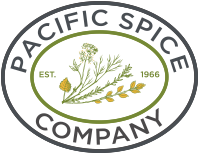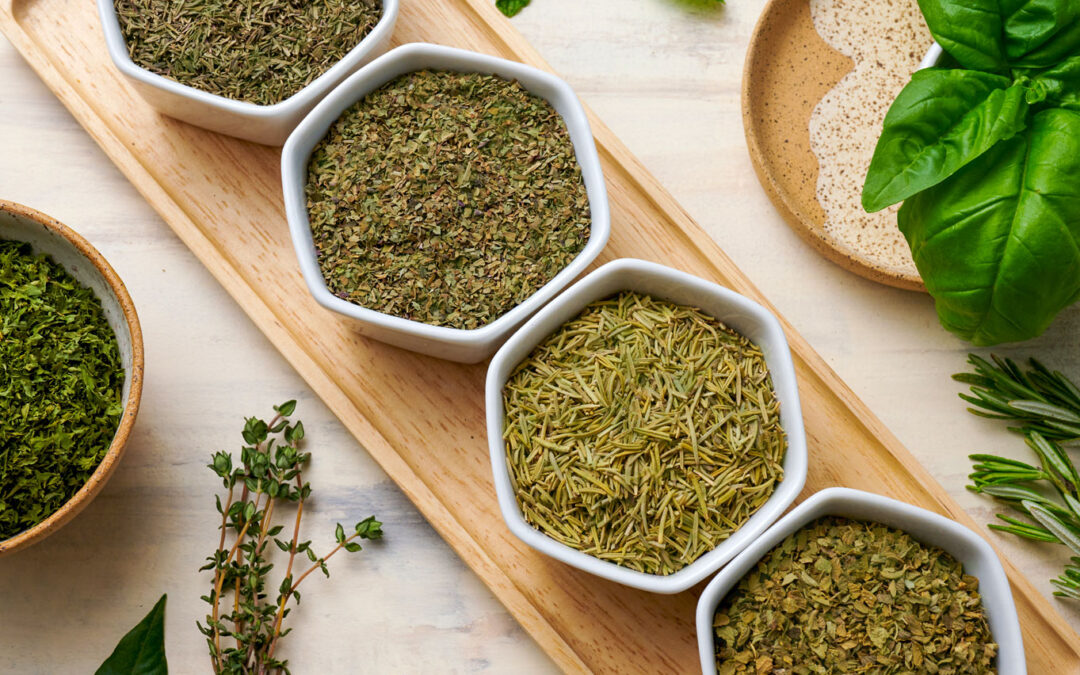Cooking with herbs is an effortless way to add flavor, fragrance, nutrition, and beauty to dishes. Both fresh and dried herbs are more than just ingredients; they are a key part of cultures around the world. Throughout history, locally grown herbs have helped define the flavors of regional cuisine and keep culinary traditions alive. This is why French dishes feature thyme, while basil is a common ingredient in Southeast Asian cuisine, and oregano is a staple in popular Greek foods.
Learning about herbs is a rewarding endeavor for food industry professionals and food enthusiasts alike. In this blog, you’ll learn all about five essential herbs, and some best practices you can follow to get the most from them.
Basil
From caprese salad to pesto, basil is a staple in Mediterranean dishes. This herb originated in India and Southeast Asia, but is now cultivated in areas around the world. It is harvested in late summer when its leaves are most aromatic.
With its vibrant green leaves, and a pleasant, aromatic flavor, basil is a versatile and popular herb that is used to enhance the flavor of sauces, salads, soups, baked goods, and meats.
Basil can be enjoyed both fresh and dry. When dried, this herb retains its essential flavor compounds which enhance its sweet and peppery flavor notes.
Oregano
Mediterranean oregano is part of the mint family, and boasts a warm, bitter flavor that is often compared to rosemary, with fresh minty undertones. This herb is native to the Mediterranean and Western Asia, and is harvested in early summer, before the plant flowers. This herb is harvested when it has the highest concentration of essential oils, and therefore the strongest flavor.
Oregano is a popular herb in Mediterranean, European, and Latin dishes and pairs well with fresh veggies, lamb, and poultry, as well as Greek salad and Italian pizza. This herb is also a key ingredient in blends like Italian Seasoning and Herbs de Provence.
This herb is notable for its antibacterial properties and robust flavor (especially when dried). In plant medicine, oregano is celebrated for its believed antimicrobial and antioxidant properties.
Thyme
With its fresh and fragrant flavor, thyme is often described as minty, earthy, citrusy, and even floral. Originating in the Mediterranean , thyme is a staple in French provencal cuisine. Thyme is harvested mid-summer, just before it flowers, for optimal flavor.
Thyme is a key herb in the bouquet garni (used to flavor soup, stock, and casseroles), as well as the popular French blend, Herbs de Provence. Thyme is well suited for roasting, baking, and braising, and for flavoring steak and stews.
One fun fact about thyme is that it contains thymol, which contributes a strong, earthy flavor, and acts as a natural preservative.
Rosemary
Rosemary is easily identified by its needle-like leaves and pungent aroma, and is a common herb in Italian and Mediterranean cuisine. The flavor of rosemary is piney, woodsy, and slightly bitter. It also has light flavor notes of pepper, lemon, and mint. This plant is harvested late spring to early summer just as it begins to flower.
This very fragrant herb adds distinctive flavor to dishes like lamb, pork, and roasted vegetables. Because it has a strong flavor and a durable constitution, rosemary is effective for use in marinades because it tolerates cooking temperatures well. It is also a common herb for baked goods and oil infusions.
Parsley
This versatile herb is known for its vibrant, leafy appearance and appealing, slightly peppery flavor. This delightful herb is from the Central Mediterranean, originating in Southern Italy, Algeria, and Tunisia. The parsley plant is harvested twice a year in the spring and the fall, and is dried for year-round use.
Parsley is a favorite garnish, and is often included in many spice blends, and soup and sauce recipes. It adds a pop of color, flavor, and freshness to dishes like ta tabbouleh and chimichurri, and is rich in vitamins A, C, and K, as well as antioxidants and minerals.
Harvesting and Processing Herbs
Harvesting herbs is a delicate process that affects the lifetime of the herb. Flavor, aroma, and shelf life are all impacted by harvesting practices as well. It is generally recommended to harvest herbs just before they flower and early in the day. High essential oil content directly impacts optimal flavor and aroma, and essential oil content is at its highest in the early morning.
After the herbs are harvested, they are either shipped to be sold as a fresh product, or they undergo a careful drying process. Gentle sun and shade drying methods are used to dehydrate herbs while preserving their essential oil content and color. Mechanical drying methods are preferable for large-scale production and use controlled environments to ensure product consistency and efficiency. Both manual and mechanical drying techniques are designed to preserve the flavor, aroma, and color of herbs while extending their shelf life.
Innovative Uses for Common Herbs
There are so many innovative ways to use herbs in your culinary creations.
Herbs are ideal for experimenting behind the bar (we feature lavender, sage, and mint in these spiced mocktail recipes). They can be added to any fruit or veggie salad, and can beautify any dish when used as a garnish. Herbs can also be added to seasoning blends to add depth and complexity, used for aromatherapy, and made into infusions.
While both dried and fresh herbs can often be used interchangeably, there are advantages to working with dried herbs. These benefits include a more consistent flavor and longer shelf life. Dried herbs also tend to be more cost effective and have a more potent flavor and aroma.
How to Substitute Dried Herbs for Fresh Herbs
Knowing how to substitute fresh herbs for dried herbs (and vice versa) is a crucial skill for any culinary professional. Dried herbs are valued in the food industry for their long and stable shelf-life, and ease of use.
When a fresh herb is dried, the water evaporates and leaves behind a more potent product. Because dried herbs have a more concentrated flavor than fresh herbs, you need less dried product to achieve the same flavor.
If a recipe calls for fresh herbs, it’s easy to substitute dried herbs, using a general 3 :1 fresh-to-dried ratio. If you’re ever unsure about how much dried herb you should use, start with less and add more to taste.
Herbs at Pacific Spice Company
At Pacific Spice we pride ourselves in producing high quality spices and herbs. With longstanding relationships and a rigorous supplier qualification and auditing process, Pacific Spice has maintained a reputation for high quality products.
Learn about our safety standards, browse our products, and contact us if you have any questions about our herbs!.

